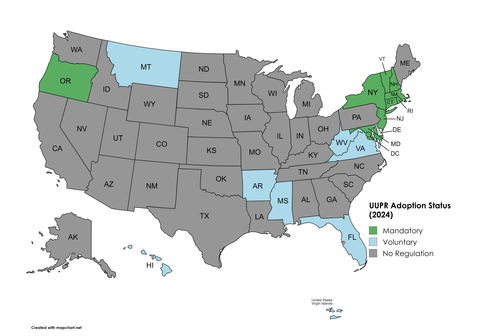A Guide to U.S. Retail Pricing Laws and Regulations
U.S. Pricing Laws and Regulations by listing state

This guide is intended to provide the user with an overview of the laws and regulations each state has relating to the retail pricing of commodities in the marketplace. Pricing laws and regulations can vary by state, so it is important to understand the pricing laws and regulations of any state in which you do business.
Weights and Measures is generally the enforcement agency of the state that is given the authority and power to ensure adherence to their pricing laws and regulations. The source of the information is provided by the state director on an annual basis.
For specific questions regarding this information, please contact the State Director.
Unit Pricing
NIST SP 1181: Unit Pricing Guide "A Best Practice Approach to Unit Pricing" (2015)
Currently, eighteen (18) states and one (1) territories have unit pricing laws or regulations in force. Ten (10) of these have mandatory unit pricing provisions. They are: Connecticut, Maryland, Massachusetts, New Hampshire, New Jersey, New York, Oregon, Rhode Island, Vermont and the District of Columbia. Nine jurisdictions have voluntary unit pricing provisions. They are: Arkansas, Florida, Hawaii, Mississippi, Montana, Nevada, Virginia, West Virginia, and the U.S. Virgin Islands. Thirty-three states have no unit pricing provisions in force. For further information and a listing of states who adopt unit pricing laws and regulations, you may visit NIST Handbook 130, Uniformity of Laws and Regulations. The chart is located in Chapter II.
Item Pricing
In addition, eight (8) states require some level of mandatory item pricing (see note below). They are Arizona, California, Connecticut, Massachusetts, Michigan, New Hampshire, New Mexico and New York. New York mandatory item pricing laws vary by county. Contact New York directly for a complete listing.
NOTE: The states listed above have exemptions to item pricing. Be sure to review the law or contact the state director for more information.
Other Resources
NIST Handbook 130, Chapter II. Uniformity of Laws and Regulations provide a listing of states and the various laws and regulations that they adopt.
Chapter III, Uniform Laws, describes the many uniform laws states adopt, including Section 7, Requirements for Unit Pricing; Section 15, Misrepresentation of Pricing; Section 22, Civil Penalties; and Section 23, Criminal Penalties.
It should also be noted that Chapter IV, Section C. Uniform Unit Pricing Regulation allows for either Metric or customary units to be used. This complements the Fair Packaging and Labeling Act (FPLA), which requires packages to have both metric and customary units net content labeling. The FPLA applies to products that are regulated by the Food and Drug Administration (FDA). The decision to provide unit price information in metric rests with retailers. Uniform Unit Pricing Regulations apply only when stores voluntarily provide unit pricing information. The unit of measure chosen must be consistent across like items within the category.
Contacts
-
General Information - OWM

